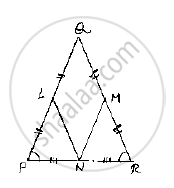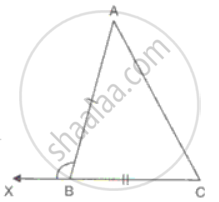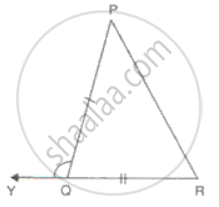Advertisements
Advertisements
प्रश्न
In a ΔPQR, if PQ = QR and L, M and N are the mid-points of the sides PQ, QR and RP
respectively. Prove that: LN = MN.
उत्तर
Given that, in PQR, PQ QRand L,M,N are midpoints of the sides PQ, QP and RP
respectively and given to prove that LN MN
Here we can observe that PQR is and isosceles triangle
⇒PQ =QR and ∠QPR =∠QRP ……..(1)
And also, L and M are midpoints of PQ and QR respectively
⇒ `PL=LQ=(PQ)/2,QM=MR=(QR)/2`
And also, PQ=QR
⇒ `PL=LQ=QM=MR=(PQ)/2=(QR)/2` .............(2)
Now, consider ΔLPN and ,Δ MRN
LP= MR [From – (2)]
∠LPN =∠MRN [From – (1)]
∵∠QPR and ∠LPN and ∠ QRP and ∠MRN are same
PN= NR [∵N is midpoint of PR]
So, by SAS congruence criterion, we have LPN≅ MRN
⇒LN =MN
[ ∵Corresponding parts of congruent triangles are equal]

APPEARS IN
संबंधित प्रश्न
If ΔDEF ≅ ΔBCA, write the part(s) of ΔBCA that correspond to ∠E
In two right triangles one side an acute angle of one are equal to the corresponding side and angle of the othe Prove that the triangles are congruent.
In an isosceles triangle, if the vertex angle is twice the sum of the base angles, then the measure of vertex angle of the triangle is
If the following pair of the triangle is congruent? state the condition of congruency:
In ΔABC and ΔPQR, BC = QR, ∠A = 90°, ∠C = ∠R = 40° and ∠Q = 50°.
State, whether the pairs of triangles given in the following figures are congruent or not:


In ΔABC and ΔPQR and, AB = PQ, BC = QR and CB and RQ are extended to X and Y respectively and ∠ABX = ∠PQY. = Prove that ΔABC ≅ ΔPQR.

In ΔABC, AD is a median. The perpendiculars from B and C meet the line AD produced at X and Y. Prove that BX = CY.
The top and bottom faces of a kaleidoscope are congruent.
Two figures are congruent, if they have the same shape.
Without drawing the triangles write all six pairs of equal measures in the following pairs of congruent triangles.
∆STU ≅ ∆DEF
